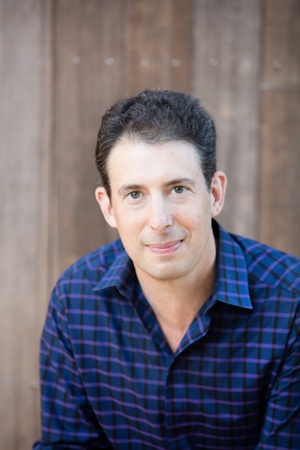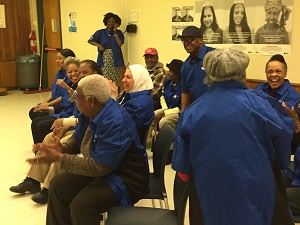Eric Klinenberg: Libraries and Social Infrastructure
Sociologist Eric Klinenberg is the Arthur Curley Memorial Lecture Speaker at the upcoming ALA Midwinter Meeting. In this Q&A about his book Palaces for the People: How Social Infrastructure Can Help Fight Inequality, Polarization, and the Decline of Civic Life, he suggests that the key to a more equitable society may lie in our shared spaces—particularly libraries.
|
|
Eric KlinenbergPhoto by Lisa DeNeffe |
Sociologist Eric Klinenberg’s newest book, Palaces for the People: How Social Infrastructure Can Help Fight Inequality, Polarization, and the Decline of Civic Life (Crown), suggests that the key to a more equitable society may lie in our shared spaces. Libraries—Andrew Carnegie’s “palaces for the people”—are chief among the building blocks of what Klinenberg terms “social infrastructure”: places where people gather, bonds form, and communities are strengthened. Recent articles in the New York Times (“To Restore Civil Society, Start With the Library”) and the Atlantic (“Worry Less About Crumbling Roads, More About Crumbling Libraries”), and an excerpt from the book accompanied by a photo essay in Slate (“The Secret Life of Libraries”), have contributed to the conversation as well.
Klinenberg, professor of sociology and director of the Institute for Public Knowledge at New York University, is the author of Going Solo: The Extraordinary Rise and Surprising Appeal of Living Alone (Penguin Pr.), Fighting for Air: The Battle to Control America’s Media (Metropolitan Books), and Heat Wave: A Social Autopsy of Disaster in Chicago (University of Chicago Press), as well as editor of Cultural Production in a Digital Age and the journal Public Culture. LJ caught up with him to find out more about his research on libraries.
LJ: How did your current focus on social infrastructure, and libraries in particular, evolve from your past work?
Eric Klinenberg: I’ve had a general interest in what I call the social infrastructure for years, since Heat Wave. After Hurricane Sandy, I was asked by the Obama administration to be the research director for this competition called Rebuild By Design that aimed to generate innovative infrastructure projects in the region affected. My job was to take these design teams, engineers and architects, and to show them and help them understand or identify the different needs and vulnerabilities and possibilities, because a lot of the teams were international and didn’t know the region especially well.
One of the design teams came up to me and said, “We’ve been listening to you talk about social infrastructure and resilience, and we’ve decided that we want to build... what we call a resilience center, and it’s going to be this new building type—it’s going to do all these amazing things…. It’s going to be a place that you have in your neighborhood, and the doors are going to be open as much as possible. It’s going to be open and available to help people during crises, but it’s going to be a place that people know well, because they’re comfortable there all the time. And it’s going to have programs for very young people, for parents, for middle-aged people, for older people. It’s going to be especially welcoming, regardless of your citizenship status. It’s going to have really good infrastructure for the Internet and communications and technology.”
They kept on describing this place, and as I listened it occurred to me that they were essentially describing libraries. And I said, “You know, this is a great idea, this resilience center, but why don’t we go look at some libraries first?”
So we did, and…I realized that libraries were doing things that not everyone understood, that I certainly didn’t understand fully, until I rediscovered them.
Around that time Michael Kimmelman, the architecture critic for the New York Times, wrote an article about this idea of mine that the library could be a really vital part of dealing with neighborhood cohesion and even climate adaptation.
Then I got a visit from Julie Sandorf, president of the Charles Revson Foundation. She knew my work on Heat Wave and other projects. [Revson had] been collecting all of these entries for the New York City branch library competition, and said, “I have all this data, and we’d really like a social scientist to sort through them.” I did look at the data, and then I started spending more time at one particular library on the Lower East Side, not too far from where I live, called Seward Park, and I got so taken with the idea that the library needed to be understood more deeply that I decided that I would spend every day for the next year in the libraries of New York. I didn’t do the data analysis that the Revson Foundation wanted, but I proposed to them that I would do a really deep study of the library and social infrastructure, and they went for it.
I was going to write a book that was just about this one particular library. Then it occurred to me that…the library is a part of the social infrastructure—it’s not the whole thing. And it would really be useful to…explain it for readers who don’t know that concept, and to show how investing in social infrastructure like libraries can help us address a whole range of problems that we’re struggling to solve.
How did the title come about?
Originally I was going to call it The Social Infrastructure, but nobody seemed to think that that was a very good idea. It seemed too wonky. Then I had this conversation with a librarian I got to know very well in Seward Park named Andrew Fairweather.
Andrew was explaining to me that he loved the idea from Andrew Carnegie that libraries should be palaces for the people; places where people would go and make their lives a little more exalted for as long as they could be there. I just love that phrase. It’s gorgeous and evocative, and I thought not only is that what a library should be, but it’s what all of our best social infrastructure should be.
What reaction has the book been getting?
It started with the op-ed that I did for the New York Times…. I was totally floored by the response. Hundreds of people wrote comments. Ordinarily when you’re an author, you never look at the comments, because they are full of hatred and invective. But the comments for the most part were people telling their own library stories.
Then I started getting emails from people who…wanted to share their library stories with me. I started getting invited to speak at libraries in cities throughout the country. There’s been lots of activity on Twitter of people telling their own stories. It feels to me like the library enthusiasts of the world have united, and everyone is making a more public case that we should view libraries not as luxuries, but as essential features of our social infrastructure. They are fundamental to our well-being.
Do you feel that people’s thinking about libraries is evolving in that direction?
I certainly hope so. I wrote the book because I want people to understand just how valuable and important social infrastructure is. I think that we fail to appreciate its significance, in part, because we don’t really have a concept for it.
Infrastructure isn’t just building a sea wall or a bridge. It’s also building the places that shape our interactions and that make our society work. I think all of us understand these days, regardless of our political preference, that our infrastructure is broken. And frankly, society is broken. We are as polarized as we’ve been since the Civil War.
People love their libraries regardless of their political preference. You go into red states and blue states and rural areas and urban areas, and people feel like libraries are special places. There’s a section of the book on education where I share stories from people who had really vivid memories of the way that the library shaped their development. Almost any time I talk to a group, people tell a library story that brings the significance of the institution to life.
What don’t people realize about libraries that you wish they did?
I think a lot of people understand what the contemporary library does…but I think there’s a world of very influential people—affluent people, heads of major philanthropies and political power brokers—who don’t use the library in the way that typical Americans do and who believe that the library is an obsolete institution…. I don’t think that reflects popular opinion.
I also don’t think people realize how woefully underfunded [libraries] are; how much investment they need to live up to the challenges that they face today. We ask libraries to do all of these things, but we treat them like luxuries in the policy world and only fund them when there’s extra money lying around, for the most part. So the bathrooms are broken, and not all libraries are accessible for people with disabilities. And, tragically, they’re not open the number of hours they need to be open.
One of the grand ambitions of this book is to establish the concept of social infrastructure so we can see it as a class of public goods that needs our support. If we don’t demand that our elected representatives support the library, then [libraries] live or die at the whims of the local political officials who are trying to balance tight budgets or philanthropists who may or may not decide a library is worth investing in.
Do you consider the library a “third space,” such as Robert Putnam defined in Bowling Alone: America's Declining Social Capital?
|
|
Library Lanes program at Brooklyn Public Library's
|
A little bit. But the third spaces that [Putnam] writes about are typically commercial places. The significance of places like libraries became even more clear this past year when we watched two African-American men get arrested for waiting too long to order in a Starbucks, because it made it clear that some of our most popular third spaces are actually not open and accessible to everyone, and in fact, can exclude, because there’s a price tag. It’s an extraordinary book, it really shaped a conversation about the state of civil society for a generation, and it’s a touchpoint for me. But I think there’s something else going on. We’re not just bowling alone anymore.
So you can only imagine how delighted I was to learn about the Library Lanes program in the Brooklyn Public Library where once a week groups of older library patrons assemble in common rooms, put on bowling league jerseys, and hook up an Xbox and do virtual bowling matches, one library team against another.
Sociologists have this term called “collective effervescence,” which refers to the spirited joy that you find when a group comes together and does something special. I saw this group of people who had every reason to be home and alone and isolated or lonely, cut off from one another, because they lived in a really tough neighborhood in New York City where street level conditions can be pretty intimidating. But because they lived near a branch library that had this program, instead of being home and alone, they were together bowling and having an amazing time. There were these wonderful moments of laughter and joy. It’s hard to calculate the value of an experience like that in the cost-benefit calculations that drive so much of our social policy today, but being there and watching that moment unfold, it felt priceless.
RELATED
ALREADY A SUBSCRIBER? LOG IN
We are currently offering this content for free. Sign up now to activate your personal profile, where you can save articles for future viewing











Add Comment :-
Comment Policy:
Comment should not be empty !!!